The shape of the universe has been a subject of hot debate for decades. You'd imagine that something as simple as whether the universe is flat or not would be easy to figure out.
But it's not for the simple reason that we're trapped inside the flat or not-flat universe, which makes it much harder to determine its shape.
From our perspective, the universe is flat. Parallel lines go on forever and, despite the effects gravity has on the curvature of space, a straight line is a straight line.
But that may not be reality, at least, not at a very large scale. New data seems to indicate that the universe is not perfectly flat but is curved. Specifically, it's saddle-shaped.
A new study of cosmic microwave background radiation, light that originates from the Big Bang, shows an asymmetry in energy and matter distribution.
That is, there's more matter and it's more energetic on one side of the universe than on the other. The laws of physics dictate that the universe is roughly the same everywhere.
The asymmetry can be explained though by a curvature in the universe. The researchers believe that the universe is slightly open or negatively curved, like a saddle, meaning parallel lines eventually diverge in the distance.
Key to this is the scale of the curvature, which is slightly bigger than the size of the observable universe. So, in practice, the universe as we see it is basically flat, but not quite.
It's still unclear whether the asymmetry in energy distribution is a statistical fluke or a sign of a real phenomenon. The asymmetry is clearly there, but physicists are still debating whether it's just a random occurrence.
If it is the consequence of a real phenomenon, it may lead to a different understanding of the period immediately after the Big Bang or even support multiverse theories.

 14 DAY TRIAL //
14 DAY TRIAL //